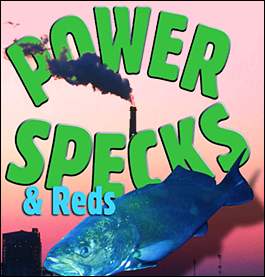|
 Power plant outfall canals consistently produce cold-weather redfish and trout action that's as hot as the water they release. Here's all you need to know to flip the switch and turn on the fun. Power plant outfall canals consistently produce cold-weather redfish and trout action that's as hot as the water they release. Here's all you need to know to flip the switch and turn on the fun.
By Chester Moore, Jr.
Page 2
"People
were literally catching hundreds of trout," says Knighten.
"Heck, that may be the reason we have limits."
An interesting
phenomena in these areas is that different species favor various
degrees of warmth or current. For example, speckled trout and
redfish are often found right next to the outflow pipes and prefer
the areas where the water is warmest. However, other species may
act differently.
Flounder often
wait down-current, and can be found in the eddies that form near
drop-offs. Since small baitfish can't negotiate current very well,
they often get stuck in those eddies and the flounder will stack
up and gulp up the shad, shrimp and whatever else ends up there.
Black drum
can often be caught in the deeper holes in these canals. I'm not
sure why, but I've caught many black drum in the very deepest
hole in the Entergy Canal. Sometimes you can drop the line right
over the boat and get hit as soon as the bait hits the bottom.
Sheepshead often feed this way, too.
Another unexpected
bonus: The deeper holes in the canal may also hold lots of freshwater
catfish.
Blue catfish
in particular can tolerate moderate levels of saltwater, so they're
often caught right alongside saltwater species. Dead shrimp will
catch a mess of 1- to 2-pound cats, but use cut bait if it's the
big cats you're after. I've found squid to be an effective alternative.
It's got the right smell, and its almost luminescent color gives
it an added visual appeal in dark water.
If that isn't
enough, striped bass and their cousins white bass, yellow bass
and hybrid bass sometimes move into saltwater outfall canals in
impressive numbers. These voracious predators can be found wherever
the bait is.
In Galveston
Bay, many of them migrate down the Trinity River; in the Sabine
area they migrate down from below Toledo Bend Reservoir. But there
are also striped bass that live in our bay systems.
The Texas Parks
& Wildlife Department stocked millions of striped bass fingerlings
a few years ago and apparently some of those fish survived to
become trophy-class fish (Editor's side-note: Many folks don't
know it, but the Galveston Bay System was home to a viable commercial
fishery for striped bass back in the early 1900s. Why they disappeared,
no one knows.). I've seen 25-pound striped bass caught out of
the Entergy Canal on the Neches River, and Capt. Knighten has
seen some impressive catches from the HL&P Canal on Galveston
Bay proper.
"That
canal isn't as consistent as the one in Trinity Bay," Knighten
says, "but the stripers and hybrids get in there pretty thick.
You can limit out on those fish in there sometimes. And they're
lots of fun to catch."
If you don't
believe these particular saltwater areas can hold some big stripers,
then take into account that the saltwater state record for striped
bass is 28 pounds and it was caught in Galveston Bay. That's a
world-class striper by anyone's standards.
Something else
to keep in mind: Even small flows from a single drainpipe can
draw fish. They may not hold massive schools of fish for long
periods of time, but even a slight warming in water temperature
can make a substantial difference in cold weather. It's very important
to look for the little things in these spots, since very often
that's all it takes to attract gamefish.
I've been a
fan of fishing warm-water discharges for a long time, and have
enjoyed numerous memorable outings on days when the "intelligent"
thing to do was to stay home where it's warm. But actually, if
catching fish makes you happy and the lack of consistent winter
action is bugging you, it might be wise to check out some of the
warm-water discharges in your neck of the woods.
They usually
hold lots of fish-fish that, not incidentally, can otherwise be
very hard to find during this weather-crazy time of year.
# # # #
page 1 / page 2
| 




